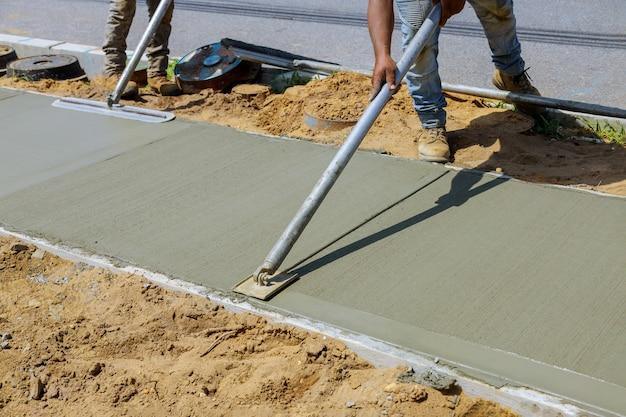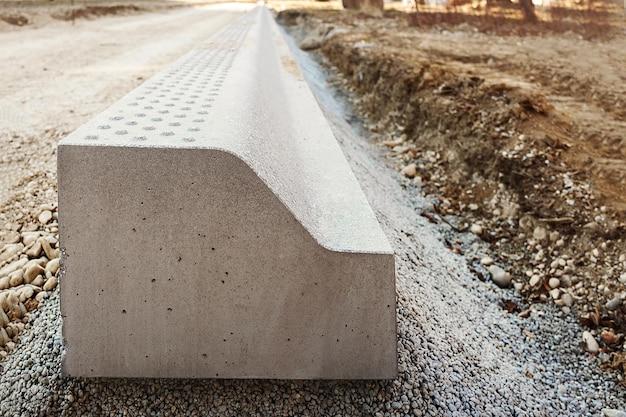Are you looking to enhance the appearance of your sloped yard while also providing structure and stability? Installing landscape timbers on a slope can be a fantastic solution! Whether you want to create a terraced garden or build a retaining wall, landscape timbers are versatile and durable materials that can transform your outdoor space.
In this comprehensive guide, we’ll walk you through the step-by-step process of installing landscape timbers on a slope. We’ll cover essential topics such as drilling holes for rebar, preventing timber warping, connecting timbers securely, and anchoring them down. We’ll also explore tips and techniques for cutting landscape timbers at an angle and joining them end to end.
So, roll up your sleeves and get ready to tackle your sloped terrain with confidence. By the end of this blog post, you’ll be equipped with all the knowledge you need to create a stunning landscape using timbers that will stand the test of time.
Let’s dig in!
How to Install Landscape Timbers on a Slope
Preparing for a Timber Adventure
So, you’ve embarked on the exciting journey of landscaping your sloped backyard? Bravo! Fear not, for landscape timbers are here to save the day. Whether you’re aiming to create beautiful terraced gardens or a sturdy retaining wall, installing landscape timbers on a slope can be a rewarding and aesthetically pleasing endeavor. But before you dive headfirst into this timber adventure, let’s walk through the steps to ensure success.
Step 1: Plan Your Timber Marvel
As with any undertaking, proper planning is a key ingredient for success. Start by sketching out your vision for the sloped area. Consider how many terraces or tiers you want to create, and think about the overall shape and flow of your landscape design. It’s kind of like envisioning a masterpiece before taking paintbrush to canvas. Take note of any drainage issues or potential obstacles that could impact the timber installation process. A clear plan will guide you through the rest of your timber adventure with ease.
Step 2: Gather Your Timber Squad
Now that you have your plan in hand, it’s time to gather your timber squad. Head to your local home improvement store and pick up landscape timbers that are suitable for outdoor use. Make sure to choose ones that are durable, preferably pressure-treated, and resistant to rot and insects. While you’re there, pick up some rebar as well. This sturdy steel rod will help hold your timbers in place. And remember, size matters! Make sure the timbers are of adequate length and thickness to withstand the weight and pressure of the slope.
Step 3: Get Groundwork Done
Before you start installing the timbers, it’s imperative to prep the ground properly. Clear the area of any rocks, weeds, or other debris that might disrupt the integrity of your timber marvel. If necessary, use a shovel to level the ground as best as you can. A well-prepared foundation will ensure your timbers stand tall and proud, like soldiers guarding your sloped landscape.
Step 4: Timber Time is Terrace Time
Now, channel your inner architect and begin the installation of your landscape timbers. Start at the lowest point of the slope and work your way up. Begin by digging a trench along the contour you want for your first terrace. This trench should be slightly wider and deeper than the timbers you’ve selected. Place the first timber in the trench, ensuring it’s level both vertically and horizontally. To secure the timber, drive a length of rebar through pre-drilled holes at regular intervals. Repeat this process for each timber, stacking them neatly and securely to create your terraces.
Step 5: Stay on the Level
As you ascend the slope, remember to level each terrace as you go. This ensures that each timber is horizontal and will provide stable support for the soil and plants. You can use a level tool and some patience to achieve a straight and true landscape paradise. Remember, this is where the magic happens, so take your time to create a structure that would even make the Hanging Gardens of Babylon jealous.
Step 6: Finishing Touches and Flair
Almost there! With your terraces in place, it’s time to add the finishing touches and bring some flair to your landscape masterpiece. Fill each terrace with soil, compacting it gently as you go. Now get creative by planting your favorite flowers, shrubs, or even herbs—whatever tickles your green thumb. The final result will be a stunning display of nature’s beauty, all thanks to your exceptional timber skills.
Step 7: Admire, Relax, and Embrace Nature
Congratulations, you’ve conquered the slope and emerged victorious! Stand back and admire the fantastic landscape you’ve created. Take a moment to appreciate the hard work, sweat, and maybe a few timber-related mishaps that brought you here. Embrace the beauty of nature that now graces your sloped backyard. It’s time to sit back, relax, and bask in the glory of your landscape timber triumph on this fine day of 2023. Well done, proud timber adventurer!
FAQ: How To Install Landscape Timbers On A Slope
Welcome to our comprehensive FAQ guide on installing landscape timbers on a slope. If you’re looking to add some dimension and structure to your hilly landscape, these FAQ-style tips will help you navigate the process with ease. From preventing warping to connecting timbers and everything in between, we’ve got you covered.
What size hole do I drill for 1/2 rebar
When it comes to drilling the right size hole for 1/2 rebar, you’ll want to go with a 5/8 inch drill bit. This slight increase in size will allow the rebar to fit snugly while ensuring enough room for easy installation.
How do you keep landscape timbers from warping
Warping can be a common concern when working with landscape timbers, but fear not! To keep those timbers nice and straight, it’s important to seal them properly. Applying a wood sealer on all sides of the timbers before installation will help prevent moisture absorption and minimize the risk of warping.
How do you put rebar on wood
Securing rebar to wood is quite simple. After drilling the appropriate holes in your landscape timbers, insert the rebar into the holes and gently tap it in using a mallet or hammer. Make sure the rebar goes in snugly to provide stability and prevent wobbling.
How do you terrace a very steep hill
Terracing a steep hill can be a challenging but rewarding endeavor. Start by planning the layout of the terraces, considering factors such as drainage and stability. Use landscape timbers to create retaining walls and level each terrace. Properly compact the soil behind each wall to ensure stability.
How do you terrace a hill with landscape timbers
Terracing a hill with landscape timbers is an excellent way to create functional spaces in your backyard. Start by leveling the area where you want to terrace, then lay out the timbers according to your desired terrace design. Secure the timbers together using rebar or sturdy screws, ensuring each tier is level before moving on.
How do you connect 6×6 timbers
Connecting 6×6 timbers is fairly straightforward. To create a strong and secure connection, use long galvanized screws or structural fasteners. Pre-drill the holes to avoid splitting the wood, and install the screws at an angle for added stability.
How do you push a wood retaining wall back
Pushing a wood retaining wall back can be a tricky task, but with some determination, it’s achievable. Start by removing any soil or debris behind the wall to create space. Then, using wooden poles or a similar sturdy object, apply pressure gradually to push the wall back into position. Take your time and be cautious to avoid causing further damage.
Should I let pressure-treated wood dry before installing
Yes, it’s essential to let pressure-treated wood dry before installing it. This drying process allows the wood to stabilize and reduce the risk of warping. It’s generally recommended to let the wood dry for at least 48 hours in a well-ventilated area before beginning your installation.
Does pressure-treated lumber warp
Pressure-treated lumber has been treated with preservatives to resist rot and decay, but it can still be susceptible to warping. To minimize the risk of warping, be sure to seal all sides of the lumber with a wood sealer before installation and follow best practices for proper fastening and support.
How many deadmen are needed for a retaining wall
The number of deadmen needed for a retaining wall depends on the size and height of the wall. As a general guideline, it’s recommended to install one deadman for every 4 to 6 feet of wall length. This will provide additional support and reinforcement to ensure the stability of the retaining wall.
Does pressure-treated wood need to dry
Yes, pressure-treated wood needs to dry before installation. Although the drying time can vary depending on various factors such as weather conditions and type of preservative used, it’s crucial to allow the wood to dry thoroughly to reduce the risk of warping and movement after installation.
How do you cut landscape timbers at an angle
Cutting landscape timbers at an angle can be achieved using a circular saw or a miter saw. Mark the desired angle on the timber, then carefully follow the marked line while cutting with the appropriate saw. Remember to wear safety goggles and exercise caution when working with power tools.
How do you anchor down landscape timbers
Anchoring landscape timbers is crucial to keep them securely in place. One effective method is to drive long galvanized spikes or rebar through pre-drilled holes in the timbers and into the ground below. This method provides stability and prevents shifting or movement over time.
Can you screw landscape timbers together
Absolutely! Screwing landscape timbers together is a reliable method for creating sturdy connections. Pre-drill pilot holes to prevent splitting, then use exterior-grade screws of appropriate length to secure the timbers together. Be sure to countersink the screws slightly to achieve a flush finish.
How do you install landscape timbers end to end
To install landscape timbers end to end, follow these simple steps:
- Mark the desired spots for the connecting timbers.
- Cut the ends of each timber at a 45-degree angle.
- Apply a wood adhesive to the cut ends of the timbers.
- Press the timbers together firmly, ensuring a tight connection.
- Use galvanized screws or rebar to reinforce the connection for added stability.
We hope this FAQ guide has answered all your burning questions about installing landscape timbers on a slope. With these tips and tricks in your toolbox, you’ll be well-equipped to tackle your slope project and create a stunning and functional landscape. Happy gardening in 2023!

